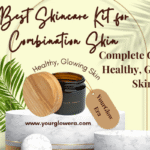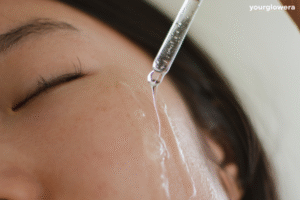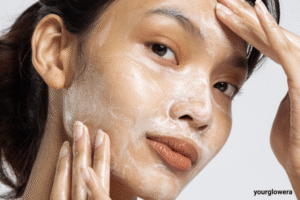Melasma, a common skin condition characterized by dark spots, can be frustrating to deal with.
If you’re struggling with melasma, you’re not alone—many people experience this condition, which often appears as uneven patches of dark skin on the face.
Fortunately, there’s hope! With the right skincare routine for melasma, you can reduce the appearance of these spots and regain your skin’s natural glow.
This blog post will provide you with a step-by-step guide on the best skincare routine for melasma, along with tips for selecting the most effective and budget-friendly products to help you manage and treat this skin condition.
Table of Contents
What is Melasma and What Causes It?
Before diving into the specifics of a skincare routine for melasma, it’s important to understand what melasma is and what causes it.
Melasma, commonly known as “the mask of pregnancy,” is a condition characterized by the appearance of dark patches on the skin, usually on the face.
These spots are more noticeable on the cheeks, forehead, chin, and upper lip. Melasma is commonly seen in women, especially those who are pregnant, taking birth control pills, or undergoing hormone therapy. However, men can also develop melasma.
The primary cause of melasma is an excess production of melanin, the pigment responsible for giving your skin its color.
This overproduction can be triggered by hormonal changes, excessive sun exposure, or even stress. If you’re looking for a solution, a targeted skincare routine for melasma can help prevent further discoloration and lighten existing spots.
How to Create a Skincare Routine for Melasma
Creating an effective skincare routine for melasma involves using products that can lighten dark spots, prevent new ones from forming, and protect the skin from UV damage.

Let’s break down a simple yet effective skincare routine for melasma that targets it:
1. Start with a Gentle Cleanser
The initial step in any skincare regimen is cleansing the skin. When it comes to melasma, it’s essential to use a gentle cleanser that won’t irritate the skin or worsen pigmentation.
Choose for a fragrance-free, hydrating cleanser that will remove dirt, oil, and makeup without stripping the skin of its natural moisture.
For sensitive skin types prone to melasma, a gentle foaming or cream cleanser is usually recommended, as it helps cleanse the skin effectively without causing irritation or dryness.
Tip: Look for products that contain ingredients like hyaluronic acid or glycerine for added hydration.
2. Apply a Vitamin C Serum
Vitamin C is a powerful antioxidant that helps brighten the skin and fade dark spots over time.
It works by inhibiting melanin production and reducing the appearance of pigmentation caused by melasma.
For the best results, I will apply a serum with stabilized Vitamin C to my face after cleansing. This helps brighten the skin, improve uneven tone, and provide antioxidant protection.
This helps protect the skin from further damage and accelerates the healing process.
Tip: If you’re new to Vitamin C, start with a lower concentration (10% to 15%) and gradually increase it as your skin builds tolerance.
3. Incorporate a Brightening Exfoliant
Exfoliating is crucial for skin renewal and fading dark spots caused by melasma.
Chemical exfoliants with ingredients like glycolic acid or lactic acid can help to speed up the turnover of skin cells, revealing brighter, more even-toned skin.
These exfoliants work by gently dissolving dead skin cells on the surface, allowing the active ingredients you apply afterward to penetrate deeper into the skin.
Tip: Use exfoliants 2-3 times per week, depending on your skin’s sensitivity.
4. Include a Retinol product in your skincare routine for melasma which improved skin renewal and texture.
Retinol, a derivative of Vitamin A, is a powerful ingredient known for its ability to stimulate collagen production and accelerate skin cell turnover.
This makes it an excellent addition to your skincare routine for melasma, as it helps to fade existing dark spots and prevent new ones from forming.
When incorporating retinol into your routine, start with a lower strength (0.25% to 0.5%) and use it in the evening.
Tip: Apply retinol in the evening to protect your skin from increased sun sensitivity caused by the product.
5. Don’t Forget Sunscreen
Sunscreen is probably the most important part of any skincare routine for melasma. Sun exposure can make melasma worse, causing the dark spots to become more noticeable.
Wear a broad-spectrum sunscreen with at least SPF 30 every day, even on cloudy days or when you’re indoors.
Choose sunscreens with zinc oxide or titanium dioxide, as these ingredients offer physical sun protection and are less likely to irritate your skin.
Tip: Reapply sunscreen every two hours if you’re outside for a long time.

6. Consider Topical Treatments with Hydroquinone
Hydroquinone is a skin-lightening agent that is often used in treating melasma. It functions by blocking the enzyme that is responsible for producing melanin in the skin.
Over-the-counter products with 2% hydroquinone are available, but stronger formulations may require a prescription.
Hydroquinone can be highly effective for lightening dark spots, but it’s important to use it as directed to avoid potential irritation.
Tip: Use hydroquinone only for a short period (up to 4-6 weeks), as prolonged use can cause skin thinning.
7. Try Niacinamide for Even Skin Tone
Niacinamide, also known as Vitamin B3, is a gentle and effective ingredient that can improve the overall tone and texture of your skin.
It helps in fading dark spots and boosts skin firmness and elasticity.
Adding a niacinamide serum to your skincare routine for melasma can help brighten your skin and decrease inflammation.
Tip: Niacinamide is suitable for all skin types and can be combined with other active ingredients like Vitamin C or retinol.
8. Apply a moisturizer to hydrate your skin and support the repair of your skin barrier
Maintaining a healthy skin barrier is essential for managing melasma and should be a key focus of your skincare routine for melasma.
A good moisturizer helps to lock in hydration and prevent the skin from becoming dry or irritated, which can worsen pigmentation.
Choose a moisturizer that contains ceramides or peptides to repair and strengthen the skin barrier.
Tip: Look for fragrance-free, non-comedogenic moisturizers that won’t clog pores or cause irritation.
9. Be Consistent and Patient
One of the most important things to remember when treating melasma is consistency.
The treatments and products you use will take time to show results, so it’s important to be patient and stick to your routine.
Most people start seeing noticeable improvements within 6 to 12 weeks, but melasma can take several months to fully fade.
Tip: Avoid switching products too frequently, as this can cause irritation and make it harder to see results.
10. Seek Professional Treatments for Stubborn Melasma
If over-the-counter treatments don’t provide the results you’re looking for, you may want to consider professional treatments like chemical peels, laser therapy, or micro needling, in addition to refining your skincare routine for melasma for more effective results.
These treatments can penetrate deeper into the skin layers and speed up the fading of melasma spots.
Always consult with a dermatologist to determine the best course of action for your specific skin type.
Tip: Always consult a dermatologist before trying new treatments to ensure they’re suitable for your skin.
Best Budget-Friendly Products for Melasma
While some skincare treatments for melasma can be expensive, there are many affordable options that can be just as effective. Here are some budget-friendly products you might want to try:
- Cleansers: Look for hydrating, gentle cleansers from brands like CeraVe or Vanicream.
- Vitamin C Serums: The La Roche-Posay Pure Vitamin C Face Serum is an excellent option for brighter skin.
- Exfoliants: Ordinary’s Glycolic Acid 7% Toning Solution is an affordable option for chemical exfoliation.
- Sunscreen: Neutrogena’s Ultra Sheer Dry-Touch Sunscreen offers broad-spectrum protection at a budget-friendly price.
Conclusion
Managing melasma can be difficult, but with the right skincare routine for melasma, you can effectively diminish dark spots and attain a smoother, more uniform complexion.
The key is consistency, patience, and using the right ingredients to address pigmentation.
Whether you’re using Vitamin C to brighten your complexion, retinol to promote skin renewal, or sunscreen to protect your skin, a well-rounded skincare routine is your best defense against melasma.
Don’t forget to consult with a dermatologist if you’re unsure about which products or treatments are best for you.

Managing melasma and dark spots requires a consistent and targeted approach. By following a dedicated skincare routine for melasma, you can effectively tackle pigmentation and achieve a smoother, more even complexion.
Don’t forget that the right ingredients and routines can make all the difference.
For more insights on how to combat dark spots, also read our post, “Transform Your Skin: A Comprehensive Skincare Routine for Melasma“, where we dive deeper into a powerful skincare routine for melasma to help you achieve clearer skin.
Incorporating the right products into your skincare routine for melasma can lead to lasting improvements.
Frequently Asked Questions
Does vitamin C serum reduce melasma?
Yes, vitamin C serums can help lighten dark spots and prevent the development of new pigmentation, making it effective for melasma.
Which vitamin is best for melasma?
Vitamin C, vitamin E, and vitamin B12 are all helpful for melasma. Vitamin C is particularly beneficial for reducing pigmentation.
Does retinol help melasma?
Yes, retinol (a form of vitamin A) helps accelerate skin cell turnover and can lighten dark spots caused by melasma over time.
Is glycolic acid good for melasma?
Yes, glycolic acid, an alpha-hydroxy acid (AHA), is great for exfoliating the skin and can help with the fading of melasma by promoting skin renewal.
Which serum is best for pigmentation?
Serums containing ingredients like vitamin C, retinol, niacinamide, and alpha-arbutin are effective for treating pigmentation.
Which tablet is best for melasma?
Oral medications such as tranexamic acid are sometimes used under medical supervision to treat melasma.
Which acid removes melasma?
AHAs like glycolic acid and lactic acid, as well as BHAs like salicylic acid, can help exfoliate the skin and fade melasma spots.
What makes melasma worse?
Sun exposure, hormonal changes (e.g., pregnancy or birth control), certain medications, and inflammation can worsen melasma.
Which supplement is best for hyperpigmentation?
Supplements like Vitamin C, Vitamin E, and tranexamic acid can help with hyperpigmentation, but it’s best to consult a dermatologist before starting any new supplement.
Can vitamin B12 cure melasma?
While there is no conclusive evidence that vitamin B12 can cure melasma, it may support skin health and appearance.









Leave a reply